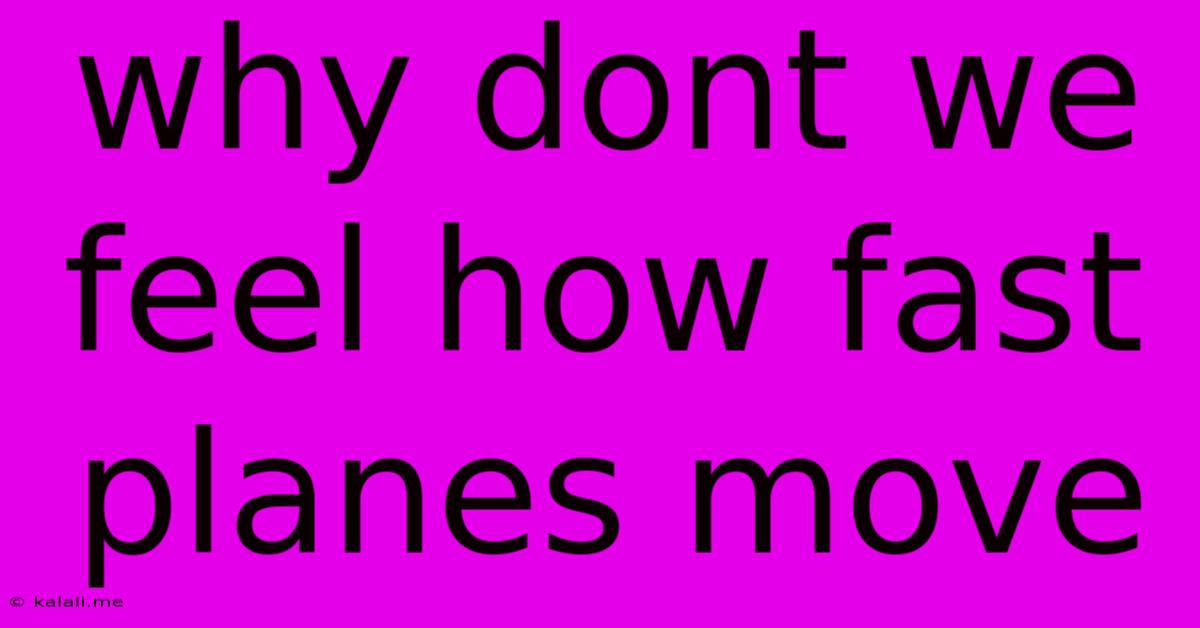Why Dont We Feel How Fast Planes Move
Kalali
Jun 05, 2025 · 3 min read

Table of Contents
Why Don't We Feel How Fast Planes Move? A Look at Inertia and Our Senses
Ever wondered why, despite traveling at hundreds of miles per hour, you don't feel the intense speed inside a plane? It's not because the plane isn't moving fast – it absolutely is! The answer lies in a combination of factors relating to our perception of motion, the physics of constant velocity, and the design of the aircraft itself. This article explores the science behind this fascinating phenomenon.
The Illusion of Stillness: Understanding Inertia and Frames of Reference
The key to understanding why we don't feel the speed of a plane is inertia. Newton's first law of motion states that an object in motion tends to stay in motion with the same velocity unless acted upon by an external force. Once the plane reaches cruising altitude and a consistent speed, it maintains a constant velocity. Within the plane, you, your luggage, and everything else are also moving at the same constant velocity. There's no force acting upon you to change your state of motion; hence, you experience no sensation of acceleration or the intense speed.
We perceive motion relative to our surroundings. Inside the plane, your frame of reference is the aircraft itself. Since you, the plane, and everything inside are moving at the same speed, you experience no relative motion. Imagine being in a smoothly moving train; if you close your eyes, you wouldn't necessarily know you're moving unless you look out the window and observe the landscape whizzing past. Similarly, in a plane, the smooth motion and lack of visible external references create a sense of stillness.
Beyond Inertia: The Role of Smooth Flight and Aircraft Design
The smooth, constant motion of a jet airplane is crucial. Turbulence, on the other hand, is a noticeable change in velocity – an acceleration – and that’s precisely when we feel the plane’s movement. The bumps and jolts experienced during turbulence are a direct result of changes in the plane's speed and direction.
Furthermore, modern aircraft are engineered for a smooth ride. Advanced aerodynamics, sophisticated flight control systems, and careful design minimize vibrations and fluctuations in speed. This meticulous engineering contributes significantly to our lack of awareness of the plane's considerable speed. This is in stark contrast to, say, a roller coaster, where the rapid changes in speed and direction directly cause physical sensations.
The Importance of External Visual Cues
The lack of easily visible external references inside a plane reinforces the sensation of stillness. Looking out of the window, of course, reveals the movement of the ground below, reminding you of the plane’s velocity. But inside, surrounded by relatively stationary objects, your brain receives less sensory input to register the high speed. This emphasizes the role of our visual system in perceiving motion.
In summary, our perception of a plane's speed (or lack thereof) is a result of the interplay between inertia, constant velocity, the smoothness of flight, aircraft design, and the absence of readily available external visual cues. It's a fascinating example of how our senses can be deceived by the consistent motion and carefully controlled environment within a modern aircraft.
Latest Posts
Latest Posts
-
How Do You Catch A Tame Rabbit
Jun 07, 2025
-
I Like To Read Philosophy Book French Translation
Jun 07, 2025
-
Can You Replace Undermount Sink With Overmount
Jun 07, 2025
-
Unzip A Zip File In Linux
Jun 07, 2025
-
How To Rip Up Linoleum Flooring
Jun 07, 2025
Related Post
Thank you for visiting our website which covers about Why Dont We Feel How Fast Planes Move . We hope the information provided has been useful to you. Feel free to contact us if you have any questions or need further assistance. See you next time and don't miss to bookmark.